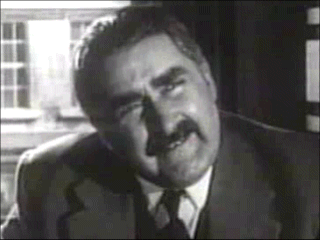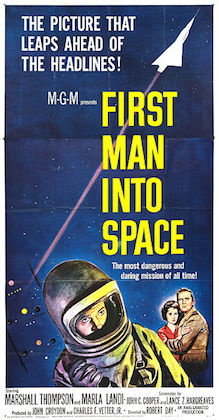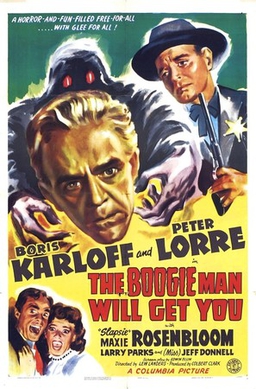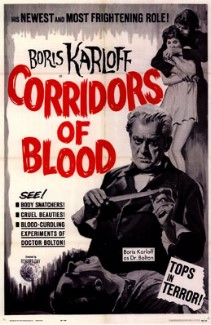
William Henry Pratt, known professionally as Boris Karloff and occasionally billed as Karloff the Uncanny, was an English actor. His portrayal of Frankenstein's monster in the horror film Frankenstein (1931) established him as a horror icon, and he reprised the role for the sequels Bride of Frankenstein (1935) and Son of Frankenstein (1939). He also appeared as Imhotep in The Mummy (1932), and voiced the Grinch in, as well as narrating, the animated television special of Dr. Seuss' How the Grinch Stole Christmas! (1966), which won him a Grammy Award.

Fiend Without a Face is a 1958 independently made British black-and-white science fiction-horror film drama from Amalgamated Productions. It was produced by John Croydon and Richard Gordon, directed by Arthur Crabtree, and stars Marshall Thompson, Kynaston Reeves, Michael Balfour, and Kim Parker. The film was released in the U.K. by Eros Films; in the U.S. it was released in June 1958 by MGM as a double feature with The Haunted Strangler.

I Was a Teenage Werewolf is a 1957 American science fiction horror film directed by Gene Fowler Jr., and starring Michael Landon as a troubled teenager, Yvonne Lime and Whit Bissell. Co-written and produced by cult film producer Herman Cohen, it was one of the most successful films released by American International Pictures (AIP).

Francis Marie de Wolff was an English character actor. Large, bearded, and beetle-browed, he was often cast as villains in both film and television.

I Was a Teenage Frankenstein is a film starring Whit Bissell, Phyllis Coates and Gary Conway, released by American International Pictures (AIP) in November 1957 as a double feature with Blood of Dracula. It is the follow-up to AIP's box office hit I Was a Teenage Werewolf, released less than five months earlier. Both films later received a sequel in the crossover How to Make a Monster, released in July 1958. The film stars Whit Bissell, Phyllis Coates, Robert Burton, Gary Conway and George Lynn.
Richard Gordon was a British-born producer and financier of horror films.

The Comedy of Terrors is a 1963 American International Pictures horror comedy film directed by Jacques Tourneur and starring Vincent Price, Peter Lorre, Basil Rathbone, Boris Karloff, and Joe E. Brown in his final film appearance. It is a blend of comedy and horror which features several cast members from Tales of Terror, made by AIP the year before.

Abbott and Costello Meet the Killer, Boris Karloff is a 1949 horror comedy film directed by Charles Barton and starring Abbott and Costello and Boris Karloff.

Torben Emil Meyer was a Danish-American character actor who appeared in more than 190 films in a 55-year career. He began his acting career in Europe before moving to the United States.

La Casa del Terror is a Mexican Monster movie starring Lon Chaney Jr. and Mexican comedian Tin Tan. The film involves Casimiro (Tin-Tan), a night watchman in a Wax Museum, whose boss, Professor Sebastian, has been secretly draining his blood to use in his experiments in resurrection. A mummy who is stolen from an Egyptian sarcophagus is revived to life, and becomes a werewolf when moonlight hits him.

The Haunted Strangler is a 1958 British horror film directed by Robert Day and starring Boris Karloff, Jean Kent, Elizabeth Allan, and Anthony Dawson.

First Man into Space is a 1959 independently made British-American black-and-white science fiction-horror film directed by Robert Day and starring Marshall Thompson, Marla Landi, Bill Edwards, and Robert Ayres. It was produced by John Croydon, Charles F. Vetter, and Richard Gordon for Amalgamated Films and was distributed by Metro-Goldwyn-Mayer.

The Black Room is a 1935 American horror film directed by Roy William Neill and starring Boris Karloff. Cinematography was done by Allen G. Siegler.

Isle of the Dead is a 1945 horror film directed by Mark Robson and made for RKO Radio Pictures by producer Val Lewton. The film's script was inspired by the painting Isle of the Dead by Arnold Böcklin, which appears behind the title credits, though the film was originally titled Camilla during production. It was written by frequent Lewton collaborator Ardel Wray. It starred Boris Karloff. Isle of the Dead was the second of three films Lewton made with Karloff, and the fourth of five pictures Robson directed for Lewton.

Frankenstein 1970 is a 1958 science fiction/horror film, shot in black and white CinemaScope, starring Boris Karloff and featuring Don "Red" Barry. The independent film was directed by Howard W. Koch, written by Richard Landau and George Worthing Yates, and produced by Aubrey Schenck. It was released theatrically in some markets on a double feature with Queen of Outer Space.

Before I Hang is a 1940 American horror film released by Columbia Pictures, starring Boris Karloff. The film was directed by Nick Grinde and was one of several films Karloff starred in under contract with Columbia.

The Boogie Man Will Get You is a 1942 American comedy horror film directed by Lew Landers and starring Boris Karloff and Peter Lorre. It was the final film Karloff made under his contract with Columbia Pictures, and it was filmed in the wake of his success in the 1941 Broadway production Arsenic and Old Lace. As he had done several times previously, Karloff played the part of a "mad scientist", Professor Billings, who is using the basement of his inn to conduct experiments using electricity to create a race of superhumans. The inn is bought by a new owner, who is initially unaware of the work Billings is conducting.

Never the Twain Shall Meet is a 1925 American silent South Seas drama film based on the book by Peter B. Kyne, produced by MGM and directed by Maurice Tourneur, starring Anita Stewart and featuring Boris Karloff in an uncredited bit part. It was remade as talking picture in 1931 at MGM by director W. S. Van Dyke. This is one of Tourneur's many lost and sought after films.

The Unholy Night is a 1929 American pre-Code mystery film directed by Lionel Barrymore and starring Ernest Torrence.

Voodoo Island is a 1957 American horror film directed by Reginald Le Borg and written by Richard H. Landau. The film stars Boris Karloff, with a cast including Elisha Cook Jr., Beverly Tyler and Rhodes Reason. It is set in the South Pacific and was filmed on Kauai, Hawaii back to back with Jungle Heat. Adam West appears in a small pre-"Batman" uncredited role.



















